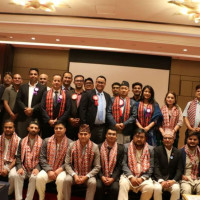- Wednesday, 2 July 2025
Majestic Trek To Tilicho
Nepal is globally considered a trekking destination amid its majestic mountain ranges. Among many, one of the most celebrated destinations is the Tilicho Lake trek, along the Annapurna Circuit. The lake is also famous for being the highest glacial lake in the world, standing proudly at an altitude of 4,919 metres.
The trek presented significant physical and psychological challenges, characterised by steep, rocky terrain and a considerable rockfall risk, a hazard exacerbated by reduced oxygen levels at high altitude. Yet, as the writer Paulo Coelho once said, “The reward is not in the destination but in the journey itself.” And indeed, reaching Tilicho Lake made every obstacle worthwhile.
I was fortunate to have my brother-in-law with me, a certified trekking guide who led us on behalf of his company, Kirtipur Travellers.
Our journey began in Kathmandu. A group of nine of us hired a jeep to Besisahar in Lamjung. The bumpy ride on Nepal’s infamous highways had already started to wear us down, and we still had another four hours ahead through the rough roads of Manang District. Surprisingly, the road wasn’t as terrible as we’d expected; though mostly unpaved, it was manageable.
Having come from the heat of the lowlands and the summer-scorched valleys, we were jolted by the freezing temperatures in Manang’s upper villages. The chill had truly set in when we reached Lower Pisang, nestled at 3,200 metres. The ever-looming concern of Acute Mountain Sickness (AMS) was in the back of our minds, so we made it a point to acclimatise gradually. That evening, we stayed at a lodge charmingly named Bob Marley Hotel.
The next morning, our real trek began. Although the motor road now reaches up to Khangsar village at 3,750 metres, it is recommended to start walking from a lower elevation to allow the body time to adjust. Our walk from Lower Pisang to Manang village took around four hours. From a hilltop along the way, the view of Annapurna II, Gangapurna, and Tilicho Peak towering above the Manang valley was breathtaking. The trail was relatively simple, weaving gently through forest and rock, and eventually, we arrived at Manang village.
As expected, Manang was more developed than most mountain settlements, serving as a vital stop for trekkers on the Annapurna Circuit. Cafés, bakeries, and well-equipped lodges lined the streets. For a moment, it felt like a Himalayan version of Thamel. Seeing in real life the village I’d so often glimpsed in Nepali films was surreal. We rested there overnight.
The next day, we set off for Tilicho Base Camp, a journey that typically takes four hours for seasoned trekkers. We took our time and completed it in six. What stood out most about this leg of the journey was the dramatic landscape, sheer rock walls rising on either side, narrow paths etched into the cliffs, and the Marsyangdi River roaring far below.
As majestic as the scenery was, the trail was no walk in the park. One constantly had to look up for falling rocks while navigating a trail barely wide enough for a single person. Specific stretches are notorious landslide zones, where loose rock and soil make every step uncertain. A major landslide had occurred just a day before our arrival, partially blocking the trail, so we had to climb over it cautiously. Meanwhile, the altitude kept rising, making every breath more laboured. The threat of AMS loomed larger with each step.
Eventually, we reached Tilicho Base Camp at a staggering 4,200 metres. Temperatures had dropped well below freezing, but luckily, the winds weren’t too fierce. Lodges in these remote regions are constructed from wood and mud to retain warmth. A central heating system, essentially a metal wood-burning stove, provided a cosy gathering point in the common areas. Supplies here are brought up by mules, making everything significantly more expensive. For instance, a bottle of water that costs Rs. 20 in the city was Rs. 200 at the base camp.
That evening, we gathered around the fire for a hearty dinner. Tired from the day’s walk and wary of the next morning’s climb, we turned in early. I had trouble sleeping due to the thin air, but eventually, exhaustion took over.
At 4 a.m., we woke in the dark chill of the Himalayan dawn. The mountain silhouettes around us were majestic, like something out of a dream. We began the final ascent to Tilicho Lake, a 700-metre vertical climb. The trail was even more perilous than the previous day, steeper, icier, and overshadowed by cliffs that could send rocks crashing down at any moment.
One notable section is called “22 Ghumti”, 22 hairpin bends that zigzag up the mountainside. It reminded me of the snaking hill roads we often drive, except we were on foot this time. For those who struggle to climb, horse services are available.As we climbed higher, I was venturing into altitudes I’d never experienced. My lungs strained in the thin air, and the destination seemed endlessly far. But after hours of trudging through ice, snow, and sheer willpower, I arrived. Words failed me.
I stood silently before the frozen Tilicho Lake, tears welling in my eyes. It wasn’t just the otherworldly beauty but the overwhelming sense of achievement. At 4,919 metres, I had reached the highest glacial lake on Earth. The lake, encased in ice, won’t melt for six months. Even in its frozen state, it was awe-inspiring. Revered in Hinduism and Buddhism, Tilicho Lake is a sacred place, and I felt humbled to be there.
I sat quietly by the lake, surrounded by mountains that touched the sky, whispering how lucky I am to be Nepali, to belong to a land of such natural wonder and spiritual depth.
After about 20 minutes, the cold winds began to bite, reminding me it was time to descend. We completed the whole trek in four days, though I would advise anyone considering such a journey to consult an experienced guide and plan extra time for acclimatisation.
One sobering observation is that plastic waste has made its way even here. I saw litter along parts of the trail, an ugly reminder of our carelessness. I sincerely hope trekkers become more mindful of the fragile ecosystems they’re walking through. This experience has ignited in me a more profound love for Nepal. I now want to explore the lush jungles of the Terai, the hills of the east, and the plains that sing in the heat of summer. Life in Kathmandu often keeps us in a relentless rhythm, but I encourage every Nepali to pause, travel, and fall in love with our country all over again.
(The author is a journalist at The Rising Nepal.)














